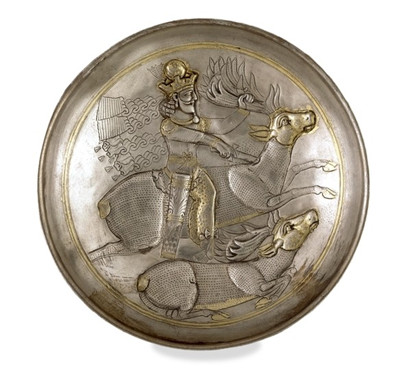In Rome at this time Christianity became the state religion, and almost contemporaneously, in Iran, the Sasanian Dynasty built a highly centralised state, in which secular and religious authority were bound together. At its height, this Iranian empire stretched from the Euphrates to the Indus-in modern terms, from Syria to Pakistan. And for several centuries it was the equal, and the rival, of Rome, in the long struggle to control the Middle East.
当时,基督教刚成为罗马国教。而在伊朗,萨珊王朝几乎在同一时期建立起了高度中央集权、政教合一的国家。伊朗帝国的领土从幼发拉底河一直延伸到印度河流域,用现代地理概念来说,便是从叙利亚一直到巴基斯坦。在数个世纪的时间里,它的实力与罗马相当,是与罗马争夺中东控制权的强有力的对手。
The Sasanian king out hunting on this programme's silver dish is Shapur II, who ruled with resounding success for 70 years, from 309 to 379. It's a shallow silver dish, I suppose it's about the size and the shape of a small Frisbee, but it's made of very high quality silver, and as you move it around you can see that it's got highlights in gold. The King sits confidently astride his mount, and on his head he wears a very large crown, with what looks like a winged globe on the top of it. Behind him, ribbons flutter over the silver, giving an impression of movement. Everything about his dress is rich-pendant earrings, long-sleeved tunic with carefully embroidered shoulder pads, highly decorated trousers and ribboned shoes. What we're looking at is an elaborate, carefully worked out ceremonial image of wealth and power.
银盘上狩猎的萨珊国王是沙普尔二世, 他在位时间为公元309年至公元379年,他成功地统治伊朗长达70年之久。这是一个浅底银盘,大小与形状都类似小号飞盘。它用上好的白银制成,一经转动还会发现它曾用黄金点缀。国王镇定地跨坐在坐骑上,头顶巨大的王冠,冠顶的装饰就像一个带翅膀的地球仪,绶带飘扬在身后,表现出动感。他的衣饰极为奢华:垂坠的长耳环,带精美垫肩的长袖束 腰外衣,装饰华美的长裤以及带缎带的鞋子。一副精心塑造的表现财富与权力的仪式性形象。













